10/24 Actinopterygian Innovations & Putah Creek
1/38
There's no tags or description
Looks like no tags are added yet.
Name | Mastery | Learn | Test | Matching | Spaced |
|---|
No study sessions yet.
39 Terms
Oviparous:
Produce eggs that hatch after
they are laid
Viviparous
Live birth: embryos are provided
nutrition in utero by mother
Ovoviviparous
Live birth: eggs develop
within female and have live birth. Nutrition
Provided as yolk-sac from egg
what type of fertilization for ovipary; provide examples
Internal or external fertilization with
egg laying; yolk provided
(lecithotrophy)
Skate cases
Nests
Broadcast spawners
Depositors
Brooders
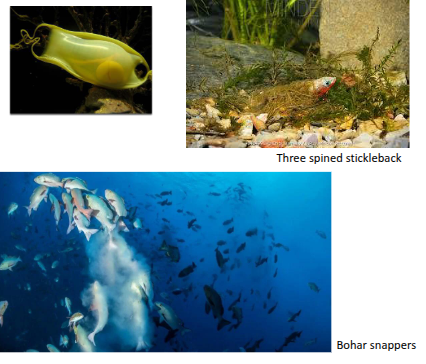
what fertilization for vivipary
Internal fertilization with live
birth; embryos nourished via
placenta or other means
Placental (Matatrophy)
Oophagy
Embryophagy
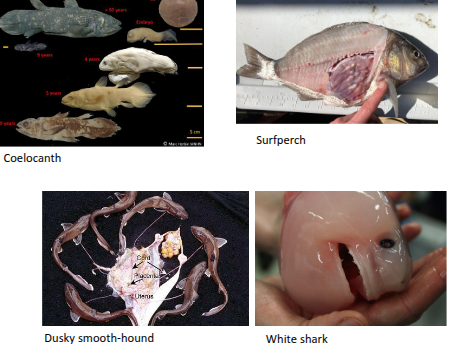
what might be assumed about carrying eggs inside vs depositing them
dangerous vs safer
ovovivipary fertilization
Internal fertilization with live
birth; eggs with yolks develop
internally in mother/(father*)
Lecithotrophy = yolks provided
Nile River
Flood irrigation (yearly)
Aquaculture and fishing for food
Nutrients from the Nile seeded the entire Mediterranean Basin
cover the land and drop tons of nutrients and
sediment
The whole thing of reincarnation comes from
the re flooding of the season and the death of the plants from
last year and the growth of plants for next year.
first fish symbols we see from egypt
fish palettes made out of stone; hold embalming materials
3150 BC
Tilapia
Tilapia = 100 species of Cichlid fishes.
• Historically important to artisanal fisheries in
Africa.
• Nile Tilapia were one of the first cultured
fishes by humans.
• Tilapia were a symbol of rebirth in Egyptian
culture and thus were often painted on tomb
walls.
• Tilapia now farmed globally
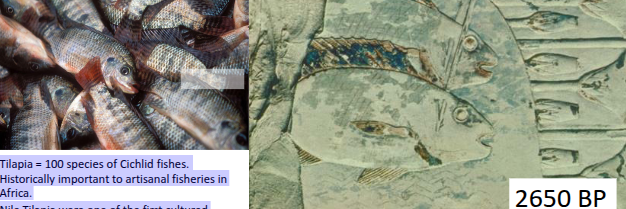
Elephantfish
symbol of
Hathor in fertility
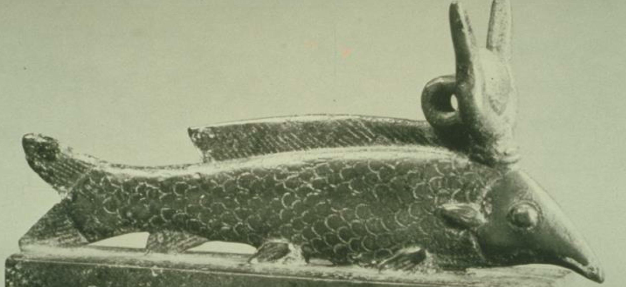
Ancient Egyptian
Fish Art: Mullet
• Mullet, FAMILY MUGILIDAE
• Likely the flathead gray mullet Mugil
cephalus.
• Coastal marine and brackish freshwater
• Filter feeders.
• White, flaky, sweet flesh
would swim up the river to spawn, some wouldn’t be able to go back down and would die after floods receded. fermented/cooked fish safe food to eat
feseekh
damning of the Aswan Dam:
when the Nile River was dammed and other rivers on the European basin
that drained into the Mediterranean, it led to a real decrease
in nutrient supply to the Mediterranean. That subsequently
led to a decline in fisheries in the Mediterranean. Why?
Because the nutrients from the Nile decreased the amount
of material and nutrients available for primary production,
phytoplankton, which fed zooplankton, which fed fishes.
actinopterygiians have what features
True rayed fins
Heavy scales or scutes
Opercular covers to protect gills
Swim bladders to help energetically
Heterocercal tails
Ancestral ray-finned fishes
Cladistia
Chondrostei
Neopterygii
radiated in the ? and became mostly extinct in the ?
Radiated in the
Silurian-Devonian
Mostly extinct by Permian
Teleostii
Emerged in parallel,
but began a major
radiation in the
Triassic
“modern fish”
Actinopterygian Innovation #1
Flexible fin
rays
Photo: Amber Manfree
1. Fins are flexible.
2. Most fins are also collapsible.
3. Supported by flexible jointed rays with a unique bilaminar
(i.e., having 2 structures) structure that allows for active
control of fin surface conformation.
4. Possess multiple sets of fins that allow them to take
advantage of diverse hydrodynamic conditions.
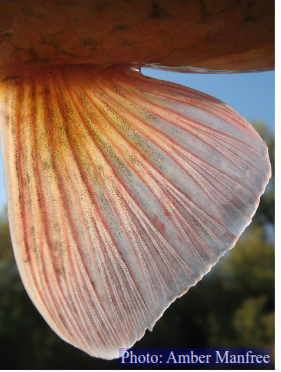
Actinopterygian Innovation #2
Fully Ossified Skeleton
• Not entirely a new feature (Sarcopterygians also partly ossified)
• But calcified skeletons are retained
in most derived fishes beginning
with the Neopterygians

Actinopterygian Innovation #3
Cladistia, Chondrostei, & Neopterygii:
Ganoid: Tough, interlocking, non-
overlapping
• Teleostii: Cycloid: Light, overlapping
and smooth
• Acanthopterygii: Ctenoid: Light, overlapping
and irregular
Actinopterygian Innovation #4:
Physoclistic Swim Bladder
• Evolutionarily related to lungs.
• “outpocketing” of the
gut
• No animals have both lungs and a
swim bladder—more derived
fishes evolved the Physoclistic
• But both types are
homologous with lungs
Actinopterygian Innovation 5:
Oviparity: Egg-laying
• Innovative?
• Lightens burden of carrying
embryos
• Makes lighter, faster, efficient fish
• Requires a predictable environment
If you're carrying the embryos around
with you, it means you're much more vulnerable to predation.
So egg-laying evolved in a different kind of environment,
possibly more stable, possibly more competition, possibly
more predation
Actinopterygian Innovation #6:
Operculum (aka “gill flap”)
Facial support.
• Protection of the gills.
• Four parts
• Vital for obtaining oxygen. Open as mouth closes
causing the pressure inside the fish the drop.
Water then flows towards the lower pressure
facilitating respiration. (hunting)
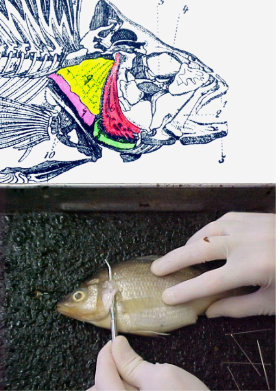
Actinopterygian Innovation #7:
Suction Feeding &
Ventilation
Adductible
operculum
&
pharyngeal
expansion
as the mouth expands, the buccal cavity begins
to expand
it means that the opercular are flaring
out
at the same time or just after, the pharyngeal arches
expand out to the back creating all this negative
space and so they essentially have a big gulp of water
that comes in
then they can close their mouth
and as they close their mouth they shove water back out
across the gills and that's the compression phase of it
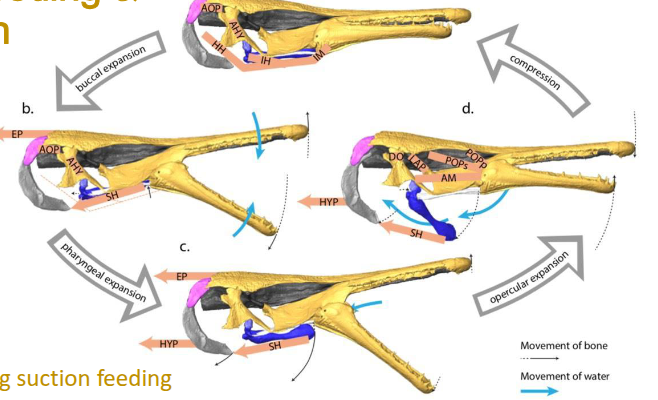
Actinopterygian Innovation 8 – Upper jaw
• The maxilla or upper jaw was
a key development in the
evolution of fishes.
• Increasingly flexible maxilla &
premaxilla
• Increased gape
• Improved suction feeding &
ventilation

Actinopterygian Innovation 9 – Improved Tail
heterocercal to homocercal: difference is
that the axis of thrust changes from being non-vertical to
vertical
for a fish that's relying upon being fast
and mobile and flexible, it needs to be able to move into and
out of situations quickly, and that homocircle tail combined
with the shape of the pectoral fins and the pelvic fins
gave it the ability to navigate in a more interactive way
through the water column and provided adaptive opportunities.
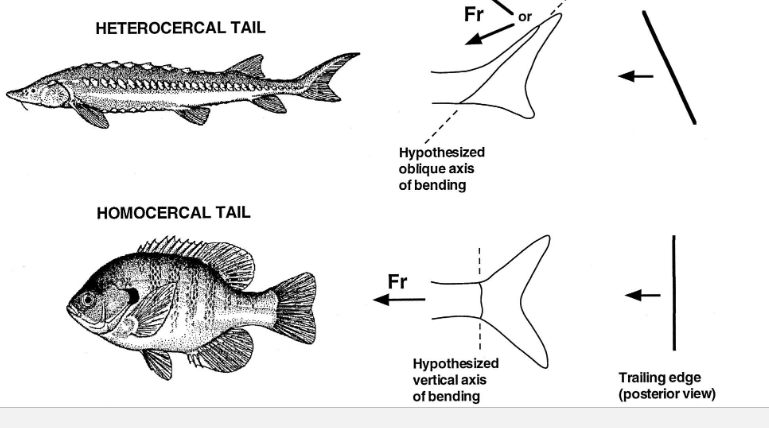
Bichirs
CLASS ACTINOPYTERYGII
SUBCLASS Cladistia
ORDER Polypteriformes
• All bichirs have lungs, a skeleton made mostly of cartilage, and a
uniquely divided dragon-like dorsal fin.
• Restricted to Africa – but not uncommon
• Reach lengths to 90cm Lungs
• Popular in the aquarium trade. lay Eggs
• Sister to all other Actinopterygians. Ganoid scales
• Long vexed evolutionary scientists
- ganoid scales

Sturgeons: morphological characteristics
CLASS ACTINOPTERYIII
Subclass Chondrostei
Order ACIPENSERIFORMES
Family Acipenseridae
Appeared 250-200 million years ago
Cartilaginous skeleton (but have the ray fins)
Egg-laying, external fertilization
Gills, not lungs
No scales – skutes
Physostomous swim bladder
Heterocercal tail
• Five rows of bony scutes along the body
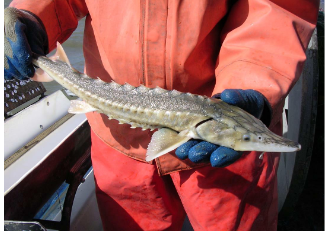
sturgeons: found where and diet
• Northern hemisphere (except Greenland)
• Freshwater and anadromous
• Inhabit lakes, large rivers, nearshore coastal areas
• Feed on mussels, crustaceans, invertebrates, plants
• Tetraploidy to Octoploidy (number of chromosomes)
Paddlefish
CLASS ACTINOPYTERYGII
SUBCLASS CHONDROSTEI
ORDER Acipensiformes
Family Polyodontidae
2 genera, 2 species
• 1 species native to the Mississippi Basin,
the other the Yangtze Basin.
• Similar to sturgeon: retain heterocercal tail,
cartilaginous skeleton.
• Eggs with external fertilization
• No bony plates: only few minute scales.
• Large rostral paddle.
• Large, planktivorous fishes
Rostral Paddles on paddlefish
Ampullae, especially on juveniles,
used to detect weak electrical
currents developed by individual
plankton like water fleas, Daphnia
spp.
• Also functions as a stabilizer

Threats to Paddlefish
Live for 30 years and attain lengths
>2m.
• Loss of spawning habitat = fast flowing
with clean gravel bottoms.
• Spawning areas degraded by damming
which leads to lower flows and
siltation.
• Commercially and recreationally sought
for their meat and caviar.
• The Chinese paddlefish was more
ancient and rarer than Mississippi –
now extinct
main threat to Chinese paddlefish
the construction of dams.
gars
CLASS ACTINOPTERYGII
Subclass Neopterygii
ORDER Lepisosteiformes
• 1 family, 2 genera, 7
species
• Appeared 200-150 million
years ago.
• Bony skeletons!
• Swim bladder vascularized
for air breathing
• Tolerate swampy low
oxygen conditions.
• Ganoid scales.
• Heterocercal tail
• Eggs– external fertilaztion
• Mostly North American
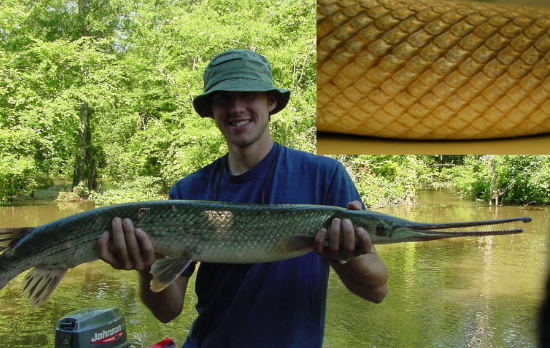
bowfin
CLASS ACTINOPTERYGII
Subclass Neopterygii
ORDER Amiiformes
1 family, 1 genus, 1 species
Bowfin
Near-teleostian features: Bony
skeleton, hinged maxilla,
cycloid scales
Symmetrical heterocercal tail
Vascularized physostomatic
swim bladder for facultative
air breathing – for slow
moving, low-O2 waters (like
gars)
Bony head with distinct “gular
plate” on lower jaw
Piscivorous ambush predators
se US
slow moving low oxygen water
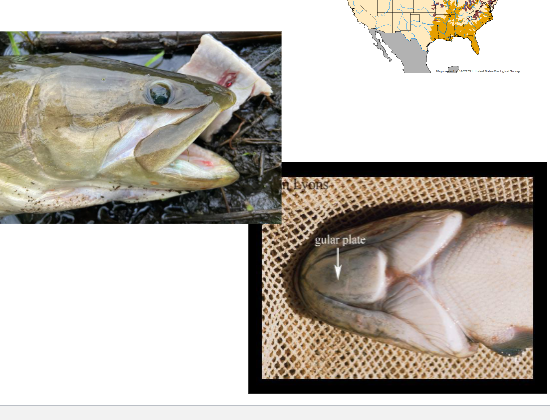
The Elasmobranchs,
Ancestral Actinopterygians, and Teleosts
all evolved rapidly during the
Cenozoic Era
Legal issues focused on providing flows
for native fishes. F&G Code Section
The “owner of any dam shall allow sufficient water at all times...to pass over,
around, or through the dam, to keep in good condition any fish that may be
planted or exist below the dam.”
1. Keep the creek from drying up
2. Spring flows for native fishes
3. Fall attraction flows for salmon
4. High flows to flush non-native fishes
5. High flows for channel processes
the natural flow regime
rivers had a kind of order to
the flows, to the maximum pulses that ran down it. And those
flows did what I just talked about. They created certain kinds
of habitat structure they find the gravels, they supported
certain kinds of fishes and food production
Functional flow regimes work!
• Prior to accord (1990s), few salmon.
• 2013: <10 Chinook salmon
• Increasing salmon each year after
• 2015-2017: >500 salmon
• 2018: 34,000 out-migrating
juveniles in the screw trap
when is classical restoration unattainable
combination of both
both physical and the biotic together. When they've
gone too far
